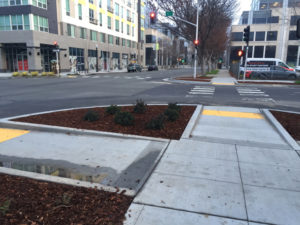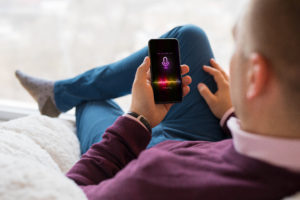At one point or another, we all experience exclusion in our lives. Rarely, however, is it as collective an experience as this past spring has been. Whether it has been exclusion from your place of work or worship, or the ones you love – physical distance is something we can never truly transcend. As we continue to navigate this time of exclusion from many of the day-to-day parts of our lives, it’s a perfect time to reflect on how inclusion has led to historic breakthroughs in design and innovation that benefit us all.

Imagine for a second the feeling none of us have missed during this period of social distance; being rushed and generally uncomfortable while traveling to a conference or trade show. You know where you are going, but your flight was delayed and you don’t have time to stop by your hotel. Thankfully, all you’re carrying is your new 4-wheel suitcase and an over-the-shoulder bag. Nevertheless, there are multiple city blocks between you and your first presentation and traffic is moving so slow that you opt to walk.
At every intersection you encounter, the curb gently slopes down from the sidewalk to the street providing a smooth on and off ramp for your luggage. As you wait for the pedestrian walk signal to change, your phone buzzes with a new email notification from the event organizer. You have to respond, but your left hand is keeping your luggage from rolling into the intersection – so you quickly tell your smartphone’s assistant to compose a message using your voice. As you watch the words magically appear on your screen, the light has changed. Luckily an anonymous chime rings from somewhere in the area causing you to look up and see that the signage has been updated to grant your passage across the street.
This situation is both trying and yet somewhat typical. Most of us have experienced some facet of this journey, but what we don’t often recognize is the assistance we received along the way. These breakthroughs didn’t come easily though. They were tirelessly fought for and earned by those who were without a choice, excluded from the ‘average’ way of life.

First, let’s look at the curb ramp. This little dip in the terrain that simplified your transition from one block to the next is a direct descendent of some of the world’s first disability rights activists. Ed Roberts of Berkeley, California was a polio survivor who became paralyzed from the neck down. Roberts was the first student to attend UC Berkeley while relying on a wheelchair, but the full functionality of the campus was still primarily designed for those without disabilities. With the help of the Physically Disabled Students Program he founded, Roberts developed a solution called ‘curb cuts’, which began with small rogue batches of cement laid to create a ramp from the street to the sidewalk. These early prototypes evolved to subtract material from the curb, ultimately laying the path for the ubiquitous curves found on nearly every corner of America today.
Next, your smartphone. The touchscreens we enjoy inside every iPhone today are in fact the longtime pursuit of FingerWorks founder and engineer Wayne Westermann. Westermann sought solutions to help him continue to interact with computers despite his worsening carpal tunnel syndrome, which Apple decided to purchase, leading up to the first iPhone release. Similarly, email itself is a product of inclusive design. Vint Cerf was an architect of the early internet. Cerf is hard of hearing and his wife is deaf. Cerf designed email as a fast and simple way to communicate with her, which when combined with vibrating alerts proves to be an incredibly effective solution. Lastly, for the person who is blind or physically unable to type, voice-to-text is nothing short of a miracle those of us who aren’t excluded could never truly understand.

Furthermore, Ed Roberts’ revolutionary ‘curb cut’ isn’t just for the conference attendee who is late or the student activist in a wheelchair. It is also for families with strollers, a child learning how to ride a bike and hipsters on electric scooters. Legend suggests the original mechanical typewriter, though designed by an able-bodied man, wasn’t in fact designed for one. Rather, Pelligrino Turri designed the first known typing machine for a young woman who was losing her eyesight and wanted to retain the ability to scribe her thoughts. Your car’s cruise control didn’t originate from the experience of an ‘average’ driver, but rather a passenger who was blind and tired of his lawyer’s stop-and-go driving. Closed captions were originally designed for the deaf or hard of hearing, but for anyone who can read, they help digest information in situations where audio is not accessible or appropriate. Similarly, captions laid the groundwork for subtitles, which allow us to enjoy content from all around the world – including this year’s Academy Award winning Best Picture Parasite.
One thing these snapshots of inclusivity show us is that we have to be more cognizant of the ways in which history is hidden in plain sight. We all tend to benefit from the designs for excluded communities, but rarely do we acknowledge their contributions. According to the World Health Organization, there are at least one billion people in the world with disabilities. Surveys in the United States suggest that over 40 million Americans (12 percent) identify as disabled – making it one of the largest minority groups in the nation. Furthermore, it is with near certain probability that each and every one of us will become ‘disabled’ in some capacity in our lifetimes – whether it be temporarily, through accident, or simply from aging.
When it comes to technology and design, the shift we are seeing takes what has been commonly referred to as ‘accessibility’ and redefines its place within the design process. Accessibility has often served as a means of abiding by the legal standards put forth by the Americans with Disabilities Act of 1990. When a product is more or less finished, design teams then consider the aspects of their work that are not accessible by disabled persons. According to Kat Holmes – author of Mismatch: How Inclusion Shapes Design, accessibility is a design attribute – but what designers need to accompany it with is a method. That method is inclusive design, which takes traditionally excluded populations and brings their perspectives to the forefront of the design process.

As the title of Holmes’ book suggests, our world is full of interactions that don’t always align, especially for those of varying abilities. An inclusive designer is someone who “recognizes and remedies mismatched interactions between people and their world”. The benefits of this work serve not only society as a whole but can also help companies and organizations avoid costly mistakes when designing without a deeper understanding of how exclusion affects their potential customers. “The experience of excluded communities”, Holmes writes, “gives insight into a diversity of ways to participate in an experience”.
Now that we have all been reminded of what it feels like to be excluded, I hope we will strive to avoid design for ‘average people’ and continue to expand our understanding of the scope and depth of the user experience.
To learn more about this growing field of design and the history of excluded communities, check out Mismatch: How Inclusion Shapes Design (MIT Press) and the groundbreaking documentary Crip Camp: A Disability Revolution.


